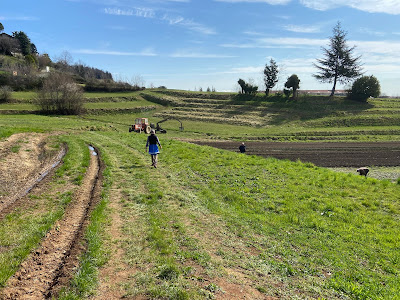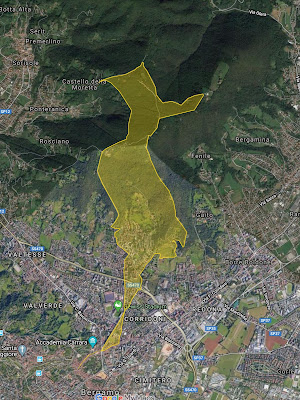previous lesson | this lesson | next lesson
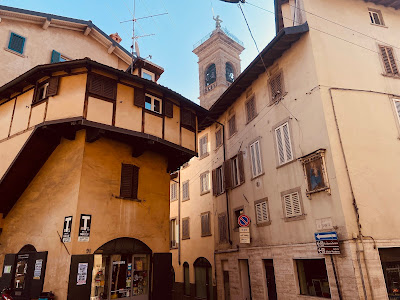

Left: Via Pignolo Alta, Piazzetta del Delfino with Sant'Alessandro looking down from the belltower, powerless to help against an invisible invader. Right: Doors of a palazzo with messages of hope tutto andrà bene.
March 24, 2020. Home. Again. The fourth day without even opening our apartment door. The last set of restrictions removed jogging as a possibility: physical activity, even individually is now banned. We had been jogging in the early morning, encountering no one and running on the back roads behind Bergamo. We felt it was safer than buying groceries which puts you much more in contact with people.
To be honest, the reasons for the tightening of the restrictions especially the part about exercise aren't entirely clear to us. Perhaps some people had been abusing and interpreting the part permitting personal exercise a little too liberally and now the permission has to be removed altogether? There is a strong, unwritten sense if someone is outside without a valid reason then it's not fair to others. Reciprocal obligations in a society. What a thought.
Before the total ban on exercise, we experienced some shaming from friends when we told them we went for a morning jog - and it was still allowed! There are fines if caught out without a valid reason, but besides that, the embarrassment would be unbearable. Now, we jog in place in our apartment.
However the new restrictions came to be, we accept them. It's the right thing to do to stop transmission.
The staying-at-home bit is a bit draining but manageable. Days blends together. The quiet streets are an unexpected positive of the lock down. No more straining Piaggio Apes sounding like they are stuck in the wrong gear or noisy Motorcross motorcycles with whiny 2-stroke engines. Just the occasional footfall of someone walking quickly.
We need groceries. We get suited up: list, masks, gloves, disinfectant, and verbal reminders: don't touch our faces. We are shopping for us and a quarantined couple in our building. When we call to ask what they need, he sounds disoriented and out of it. He passes the phone to his wife and we try to make sure we understand the exact products she is asking for. "Would that be disinfectant for the house or the hands?" "What is the name of the artificial sweetener again?" A day later he would be taken to the hospital.
We exit. Ironically, as soon as we are out, we want to run back home. Almost everyone wears a mask. Every cough or sign of heavy breathing throws us into suspicious mode. We are afraid to sniff or cough for fear someone will cast us a look. Sneezing is out of the question.
Ever try opening one of those plastic produce bags with gloves on? You know the type that stick together? We are in the PAM supermarket and my face is hot with the mask on and I'm sweating. I want to lick my finger like I usually do to get the two sides of the bag apart so I can put my fruit inside it but I absolutely must not.
Going to get groceries is permitted, as well as trips to the pharmacy or doctor, and strangely getting a newspaper. A locked-in older friend asks for the equivalent of the TV Guide if she knows we are going out. We haven't heard from here in a day. Note to self: we need to call Lola. We miss her bawdy jokes delivered with impeccable timing. We used to sit together in Bar Papavero and get them in person. It seems like ages ago that we had a coffee there whereas it was just a few weeks ago it closed like all other establishments. We must content ourselves with Lola's jokes over the phone.
These photos were taken on via Pignolo and via San Tomaso - our normal routes to the necessities.
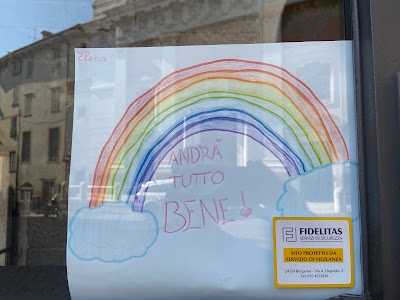


Messages of hope: everything is gonna be alright - tutto andrà bene.
Tutto andrà bene
"Everything is going to be fine"
This is a message of hope seen up and down streets, produced by kids and their families. We love to see them. The phrase uses the future tense of the verb andare - to go andrà.

Mantenere una distanza di almeno 1 metro dalle altre persone presenti in negozio. Attendere il proprio turno all'esterno, prendendo il numero, se in negozio sono già presenti 3 persone.
"Maintain a distance of at least 1 meter with other people in the store. Wait your turn outside, taking a number if there are already 3 people in the store."
This sign was posted on the door Ol Formager (cheese is essential!). It's a good example of how Italians tend to write in block letters (see Lo Stampatello: How Italians Write). It's also a complicated sign. Should go in and take a ticket and then go back outside and wait? Or wait outside and then go in and take a ticket?
The phrase attendere il proprio torno - is a stock phrase to say "wait your turn". What we can never figure out is how to choose between the imperative infinite or imperative informal. (Formal imperative would almost never be used in a sign like this.) Here, they have chosen the imperative infinitive, often used when giving instructions and a message given generically (destinatario generico). So it's mantenere instead of maintieni/maintenete and attendere instead of attendi / attendete. Let's just say we would be paralyzed when asked to make this sign.

Avviso importante - viste le nuove misure di contenimento...
"Important notice - given the new restrictions..."
The sign appears outside of "La Botiga" but apparently the official name of this shop is Panetteria Burini. Didn't know that.
The interesting language element here is viste, from the verb vedere. The sense is "seeing that". Some other examples are: viste le circostanze - under the circumstances, vista la situazione - given the situation, visto il parere - regarding the opinion, and visti i problemi - considering the problems.

Caro studente, come saprai stiamo vivendo un momento molto particolare in cui le notizie sul Coronavirus si susseguno creando una situazione caotica.
"Dear student, as you already know we are going through a challenging time in which the reports about coronavirus follow one after the other creating a chaotic situation."
This sign was on the My English School on via Pignolo. Of course, I was curious to see this sign produced by a language school and it didn't disappoint.
The first point of interest is the use of come saprai. Why simple future? Why not come sai - using present indicative? To the best of our ability, we believe this to be a modal use of the future tense, that is, a use that doesn't have a temporal sense. The use of future expresses a supposition on the part of the writer, a kind way of say "as you would or might already know". The grammatica-italiana site has a discussion of different modal uses of the future tense.
The second point of interest in the language used in this sign is the phrase vivendo un momento. The first temptation we would have is to write that like vivendo in un momento. Is there a difference? We think that, with the preposition in it means you are living in a time, a bit detached. Without in it means you are experiencing it first person. More skin in the game.
Finally, si susseguono. The verb is susseguire - to come in succession or follow one another. To make the translation work better, we need to translate le notizie not as "news" but as "reports". Then the sense of reports following one another makes sense...we hope.

In ottemperanza al decreto anti-coronavirus, l'esercizio rimarrà chisuo fino a data da destinarsi!
"In compliance with the anti-coronavirus measures, this shop will remained closed until a date to be determined."
This sign was on the gelateria next to our favorite piadina shops, Squacquerone & Rucola, on via Pignolo. This sign includes one of our new Italian words of 2020, ottemperanza - compliance. A common confusion is the use of esercizio which can mean practice/scope, exercise/workout, or business/shop.

È un sacrificio necessario. Siamo convinti che solamente con il contributo di tutti risolveremo la difficile situazione.
"It's a necessary sacrifice. We are convinced that only with everyone's contribution will we resolve this difficult situation."
What a positive message! We are in this together. The phrase siamo convinti or in the singular sono convinto - "I'm convinced" can be followed the present subjunctive or the simple future as in this case, risolveremo - future simple of risolvere. Remember the future tense has one M and the conditional two, which would be risolveremmo - "we would resolve".

L'enoteca rimane chiusa. Il rispetto delle regole è l'unica arma che abbiamo.
"This wine shop is closed. Compliance with the rules is the only weapon we have."
Another positive message and solidarity. Respect - il rispetto - in this phrase is better read as compliance withe the rules.

Gentile cliente. la situazione sanitaria ci impone di prendere misure drastiche che ci obbligano per il benessere vostro e nostro e dover chiudere l'attività fino al 16/3/20. Siamo sicuri che questa scelta verrà favorevolmente accolta e confidiamo di rivedervi presto.
"Dear customer, the health situation requires us to take drastic measures that require us for your well-being and ours and to have to close our business until 16/3/20. We are sure that this choice will be looked upon favorably and we trust to see you again soon."
Okay, like who are we to criticize, but this closure sign is a bit wordy and to our ears there is a bit of "we are forced to do this and we would rather not" underlying the message. Ci impone - "we are required" or "compels us". Ci obbligano - "require us" or "compel us". Dover chiudere - "we must close" in a forced sense.

Se in questo periodo preferite stare a casa, persone anziane in primis, offro la mia disponabilità a far la spesa o altre commissioni ovviamente tutto gratis.
"If in this period, you prefer to stay at home, above all the elderly, I'm offering my availability to get groceries and other small errands, obviously free of charge."
It's nice to see people offering there services to help out others in these stressful times. in primis - is a Latin phrase meaning "the first place" or "above all". persone anziane - can be older people, elderly people, or older persons. Speaking of the phrase stare a casa, a common message and hashtag during the Coronavirus pandemic here in Italy is #iostoacasa - "I stay home" though in English it reads better to say "I'm staying home".
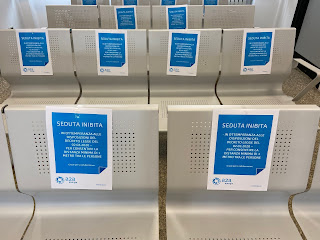




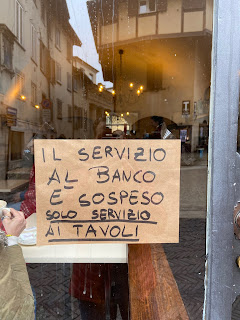







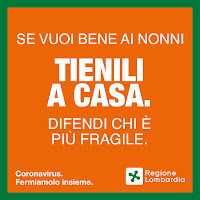

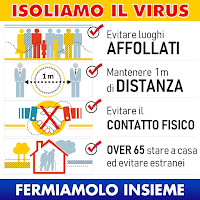

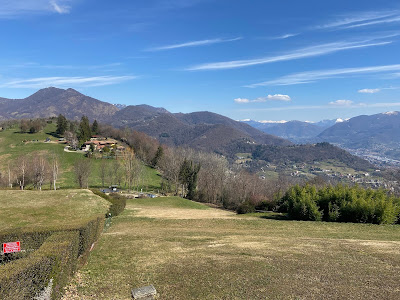




![[Apocynaceae] Vinca major – {Pervinca maggiore} [Apocynaceae] Vinca major – {Pervinca maggiore}](https://blogger.googleusercontent.com/img/b/R29vZ2xl/AVvXsEitDKBbupXlF2XY3vEXEB753D9o-eK_VGx0yz290hne-jPqZgf-s_Df8e6MyrM52CNxcxnAJBmKBJV9gOTsy6pls2wzELcNvkjWI2g2yBNEdzAn8NFYmIMxCrSaMTIjVcUus7yT2ejKPN4/s400/%255BApocynaceae%255D+Vinca+major.jpg)
![[Boraginaceae] Pulmonaria sp. – {Polmonaria} [Boraginaceae] Pulmonaria sp. – {Polmonaria}](https://blogger.googleusercontent.com/img/b/R29vZ2xl/AVvXsEhRsLrNd9cKUJ0wmRnmUe5ujkQPzT6dmroHOjmxbIlBJCn67DpLynr12aGowWDlqJc5gYEYOHtzRSdUB344e9qT3rOm8gIoG_YYmHL-07W0y-aPOA0APyKvj_MQ9dnUZEJcDz3_R66wNfY/s400/%255BBoraginaceae%255D+Pulmonaria+sp..jpg)
![[Ranunculaceae] Hepatica nobilis {Erba trinità} [Ranunculaceae] Hepatica nobilis {Erba trinità}](https://blogger.googleusercontent.com/img/b/R29vZ2xl/AVvXsEh58KgWVKMmpzH-gpcX0KIihzedcxRfBkgGsIWlOJhWG559n9H7w1z-dX4gyovry6TuWujzrELsFx4BWQrvwOwZuHcky-yfkRJRIMAkta3A87M7hnIBEx_fd0IlwRRJemGRHDh0Z_skeY8/s400/%255BRanunculaceae%255D+Hepatica+nobilis.jpg)
![[Violaceae] Viola odoratum – {Viola mammola} [Violaceae] Viola odoratum – {Viola mammola}](https://blogger.googleusercontent.com/img/b/R29vZ2xl/AVvXsEjG0u0ObKG0qBM5mZZn0adamMCUy6jPAFRLQxLDY8Ixoo8GDzboxcmXR48_IbmiSUYkYmJQKcBHs4_0cDrwu-iIaRK7dL5oKTfro_rT1wm-Bh2QYx8X6I45iKXiTV5Dkfc0cZEl3wmMBeU/s400/%255BViolaceae%255D+Viola+odoratum.jpg)
![[Asteraceae] Bellis perennis – {Pratolina comune} [Asteraceae] Bellis perennis – {Pratolina comune}](https://blogger.googleusercontent.com/img/b/R29vZ2xl/AVvXsEh8u1-bwFdpnLmYF1BW0iIoX5N0jUYCrMaarA2O36cA0XL8wSzveffO3rGcTU8qbjk-A81_yZiqs1mY0YAFt8b5T2e5GJSbMxREtSaXsmBvLeCfft9l2g0mCgcXK6uDu1fah-icYaOGE6Y/s400/%255BAsteraceae%255D+Bellis+perennis.jpg)
![[Euphorbiaceae] Euphorbia helioscopia – {Euforbia calenzuola} - This is just a guess on the species. [Euphorbiaceae] Euphorbia helioscopia – {Euforbia calenzuola} - This is just a guess on the species.](https://blogger.googleusercontent.com/img/b/R29vZ2xl/AVvXsEidMZRt3SkWvzOXb21ok_j6RKaAQTwbTUanHlQGuLB0PAfiNRw_DnH8VAwyQUtiAe1YwJO2I3iSm42eW5wZr3yRxh9Jtf56xoyN8CAUzMBTSHZcip5MeGm4EV_-pi973EQZYvur2SI4V_c/s400/%255BEuphorbiaceae%255D+Euphorbia+helioscopia.jpg)
![[Liliaceae] Erythroninum dens-canis – {Dente di cane} [Liliaceae] Erythroninum dens-canis – {Dente di cane}](https://blogger.googleusercontent.com/img/b/R29vZ2xl/AVvXsEgeuApdK0dyq-yjoLg61fmzE5iAxzNhAFZdWYIeRqZbGLnBlMlBmTTxGHl_yi9AWt-JhXDOwPqZo7LjnK9SnrnbHF0NzF1e8Btk_WmJHfLBcFWMYFIYa308gTPaoLJ1naS_0P7dCimBHNU/s400/%255BLiliaceae%255D+Erythroninum+dens-canis+1.jpg)
![[Liliaceae] Erythroninum dens-canis – {Dente di cane} [Liliaceae] Erythroninum dens-canis – {Dente di cane}](https://blogger.googleusercontent.com/img/b/R29vZ2xl/AVvXsEjy2G8vbxaqV0gIrawSpyq0-B5a3rTCQOcWhO73TrEZq-3UoOzDhMR6axcW4NgZwhR7GkyL_-wUlJ6BMP0g1WlZT_S-_u6mb9thSQ4n0_DiwttmAouDYm-Sf344TZAUeqjLZC2LvqVf9tk/s400/%255BLiliaceae%255D+Erythroninum+dens-canis+2.jpg)
![[Polygalaceae] Polygala chamaebuxus – {Poligala falso bosso} [Polygalaceae] Polygala chamaebuxus – {Poligala falso bosso}](https://blogger.googleusercontent.com/img/b/R29vZ2xl/AVvXsEg4D3y7wkKbE7dqxz_f9BgFmWikTdyqHw-ZQdE76Cjb2nocPgdxWYHoP_GiZ2YTBtV-KQlURVY_vFLF5jCrWQu2PY51o4MZy6vOXEVu70V9pRczHkx9njo_qJIIqAhkf2wfQHT2wMQ_cKM/s400/%255BPolygalaceae%255D+Polygala+chamaebuxus+1.jpg)
![[Polygalaceae] Polygala chamaebuxus – {Poligala falso bosso} [Polygalaceae] Polygala chamaebuxus – {Poligala falso bosso}](https://blogger.googleusercontent.com/img/b/R29vZ2xl/AVvXsEjBgr6Jsjapk58I_TyMXI8OgsZfbvg8SNopcotf-pnzNcMN1Uh2wZLZGcHNAfRhSTz3HKjX8XQnttxou1rO_kyhw0h1rp0GaLKIBVj18TKmt5O13zn2w93RCpLd2ZaKIrPCZGLVrKvy4L4/s400/%255BPolygalaceae%255D+Polygala+chamaebuxus+2.jpg)
![[Primulaceae] Primula vulgaris – {Primula comune} [Primulaceae] Primula vulgaris – {Primula comune}](https://blogger.googleusercontent.com/img/b/R29vZ2xl/AVvXsEivOHLniIQyj_RVHjGYXRj5rGLrvPLF1JSq_tXtabRNAZbFSxJaFucZ6lGc5j-1NFhQK8d1QWgThu8OMR2Tw5Jcq8qwt4Yz_VW3kcsGs-1yMH3XxbOT0qOSszOOctpM5HbtDKy0KTnAJuA/s400/%255BPrimulaceae%255D+Primula+vulgaris.jpg)
![[Ranunculaceae] Anemone nemorosa – {Anenome bianca} [Ranunculaceae] Anemone nemorosa – {Anenome bianca}](https://blogger.googleusercontent.com/img/b/R29vZ2xl/AVvXsEgvMSQxjVDvRr12gk76GTG-uyD-3xJt8ehP3QgXA6A7rltBQTKG-OUTl8J9UnznawJndY0zMxHXhBzvGuygA_nkrcVPW4mqP-1YOf5hXfMj2bC6X2cb68A_AwWvq-5_DP8iBDfsZm2Kn8E/s400/%255BRanunculaceae%255D+Anemone+nemorosa.jpg)

